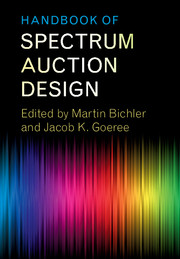Book contents
- Frontmatter
- Contents
- List of Contributors
- Preface
- List of Papers
- Part I The Simultaneous Multiple-Round Auction
- Part II The Combinatorial Clock Auction Designs
- 5 Combinatorial Auction Design
- 6 The Clock-Proxy Auction: A Practical Combinatorial Auction Design
- 7 Spectrum Auction Design
- 8 A Practical Guide to the Combinatorial Clock Auction
- 9 Market Design and the Evolution of the Combinatorial Clock Auction
- 10 Quadratic Core-Selecting Payment Rules for Combinatorial Auctions
- 11 Core-Selecting Package Auctions
- 12 A New Payment Rule for Core-Selecting Package Auctions
- 13 On the Impossibility of Core-Selecting Auctions
- 14 Ascending Combinatorial Auctions with Risk Averse Bidders
- 15 Properties of the Combinatorial Clock Auction
- 16 Budget Constraints in Combinatorial Clock Auctions
- 17 (Un)expected Bidder Behavior in Spectrum Auctions: About Inconsistent Bidding and its Impact on Efficiency in the Combinatorial Clock Auction
- Part III Alternative Auction Designs
- Part IV Experimental Comparisons of Auction Designs
- Part V The Bidders’ Perspective
- Part VI Secondary Markets and Exchanges
- Outlook
- References
7 - Spectrum Auction Design
from Part II - The Combinatorial Clock Auction Designs
Published online by Cambridge University Press: 26 October 2017
- Frontmatter
- Contents
- List of Contributors
- Preface
- List of Papers
- Part I The Simultaneous Multiple-Round Auction
- Part II The Combinatorial Clock Auction Designs
- 5 Combinatorial Auction Design
- 6 The Clock-Proxy Auction: A Practical Combinatorial Auction Design
- 7 Spectrum Auction Design
- 8 A Practical Guide to the Combinatorial Clock Auction
- 9 Market Design and the Evolution of the Combinatorial Clock Auction
- 10 Quadratic Core-Selecting Payment Rules for Combinatorial Auctions
- 11 Core-Selecting Package Auctions
- 12 A New Payment Rule for Core-Selecting Package Auctions
- 13 On the Impossibility of Core-Selecting Auctions
- 14 Ascending Combinatorial Auctions with Risk Averse Bidders
- 15 Properties of the Combinatorial Clock Auction
- 16 Budget Constraints in Combinatorial Clock Auctions
- 17 (Un)expected Bidder Behavior in Spectrum Auctions: About Inconsistent Bidding and its Impact on Efficiency in the Combinatorial Clock Auction
- Part III Alternative Auction Designs
- Part IV Experimental Comparisons of Auction Designs
- Part V The Bidders’ Perspective
- Part VI Secondary Markets and Exchanges
- Outlook
- References
Summary
Introduction
Fred Kahn recognized the important role of market design in improving how markets work. He believed that prices should be set in an open competitive process, rather than administratively. I had the pleasure of working with Fred on a project to evaluate the pricing rule in California's electricity market.We examined whether the electricity market should use uniform pricing or pay-as-bid pricing (Kahn et al. 2001). In this tribute to Fred Kahn, I also focus on auction design, but in the communications industry.
Spectrum auctions have been used by governments to assign and price spectrum for about 20 years. Over those years, the simultaneous ascending auction, first introduced in the US in 1994, has been the predominant method of auctioning spectrum. The auctions have proved far superior to the prior methods of beauty contests and lotteries (Cramton 1997; Milgrom 2004).
Despite the generally positive experience with the simultaneous ascending auction, several design issues have surfaced. Some were addressed with minor rule changes. For example, bidders’ use of trailing digits to signal other bidders and support tacit collusion was eliminated by limiting bids to integer multiples of the minimum increment (Cramton and Schwartz 2002). However, many other design problems remain. In this paper, I identify these problems, and describe a new approach—the combinatorial clock auction—which is based primarily on the clock-proxy auction (Ausubel et al. 2006), which addresses the main limitations of the simultaneous ascending auction.
My focus here is on spectrum auction design, rather than spectrum policy more generally. Certainly, communications regulators face many other critical challenges, such as how best to free up new spectrum for auction (Cramton et al. 1998), or whether an auction is needed at all (FCC 2002). For some allocations, it is better to set aside the spectrum for common property use, as is done with unlicensed spectrum. In particular, for applications that do not create additional scarcity, the commons model is better than the auction model.
- Type
- Chapter
- Information
- Handbook of Spectrum Auction Design , pp. 141 - 169Publisher: Cambridge University PressPrint publication year: 2017
References
- 7
- Cited by



